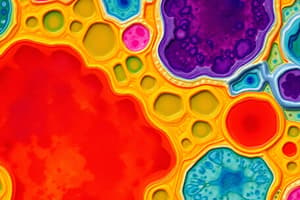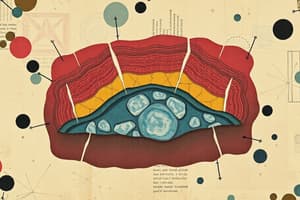Podcast
Questions and Answers
What is the primary function of epithelial tissue?
What is the primary function of epithelial tissue?
- To facilitate muscle contraction
- To transport nutrients within the body
- To store energy in the form of fat
- To provide a protective barrier against external factors (correct)
Which embryonic layer contributes to the development of epithelial cells lining the airways?
Which embryonic layer contributes to the development of epithelial cells lining the airways?
- Mesoderm
- Ectoderm
- Neural crest
- Endoderm (correct)
What component provides an attachment site for the epithelium, separating it from underlying connective tissue?
What component provides an attachment site for the epithelium, separating it from underlying connective tissue?
- Reticular lamina
- Apical surface
- Cell junction
- Basal lamina (correct)
Which feature distinguishes the apical surface of epithelial cells from the basal surface?
Which feature distinguishes the apical surface of epithelial cells from the basal surface?
How do epithelial tissues obtain nutrients?
How do epithelial tissues obtain nutrients?
What are the main functions of epithelial cells in the body?
What are the main functions of epithelial cells in the body?
What characteristic distinguishes cilia in epithelial cells?
What characteristic distinguishes cilia in epithelial cells?
Which type of cell junction is primarily involved in creating a barrier to the movement of substances between adjacent epithelial cells?
Which type of cell junction is primarily involved in creating a barrier to the movement of substances between adjacent epithelial cells?
Which type of anchoring junction links epithelial cells to the basement membrane?
Which type of anchoring junction links epithelial cells to the basement membrane?
What is the primary role of gap junctions in epithelial tissue?
What is the primary role of gap junctions in epithelial tissue?
What type of proteins are present in adherens junctions that allow them to link to other cells or the extracellular matrix?
What type of proteins are present in adherens junctions that allow them to link to other cells or the extracellular matrix?
What is the primary function of simple squamous epithelium?
What is the primary function of simple squamous epithelium?
Which type of epithelial tissue appears to have multiple layers but is actually a single layer of irregularly shaped cells?
Which type of epithelial tissue appears to have multiple layers but is actually a single layer of irregularly shaped cells?
Where is simple cuboidal epithelium commonly found?
Where is simple cuboidal epithelium commonly found?
What unique feature is associated with ciliated columnar epithelium?
What unique feature is associated with ciliated columnar epithelium?
Which type of epithelium consists of more than one layer of cells with the top layer being flat?
Which type of epithelium consists of more than one layer of cells with the top layer being flat?
What is a characteristic of transitional epithelium?
What is a characteristic of transitional epithelium?
Which type of protein is found on the cytoplasmic surface of adherens junctions aiding in cell shape and folding?
Which type of protein is found on the cytoplasmic surface of adherens junctions aiding in cell shape and folding?
What type of epithelium is characterized by a single layer of rectangular cells?
What type of epithelium is characterized by a single layer of rectangular cells?
What is the primary function of simple squamous epithelium?
What is the primary function of simple squamous epithelium?
Which type of epithelium is specifically designed to stretch and is found in the urinary system?
Which type of epithelium is specifically designed to stretch and is found in the urinary system?
How is stratified squamous epithelium primarily classified?
How is stratified squamous epithelium primarily classified?
Which type of epithelium is found in the ducts of glands and provides protection to underlying tissues?
Which type of epithelium is found in the ducts of glands and provides protection to underlying tissues?
What distinctive feature is present in pseudostratified columnar epithelium?
What distinctive feature is present in pseudostratified columnar epithelium?
Which epithelium type is found lining the mouth cavity and is unkeratinized?
Which epithelium type is found lining the mouth cavity and is unkeratinized?
Flashcards are hidden until you start studying
Study Notes
Epithelial Tissue Overview
- Epithelial tissue forms protective sheets covering body surfaces exposed to the outside and lining organs.
- Includes skin, airways, digestive tract, urinary, and reproductive systems.
- Hollow organs and body cavities are lined with endothelium, a specialized type of epithelium.
Embryonic Origin of Epithelial Cells
- Epithelial cells arise from three embryonic layers:
- Ectoderm: Skin, mouth, nose, and anus.
- Endoderm: Airways and most of the digestive system.
- Mesoderm: Vessels in lymphatic and cardiovascular systems (endothelium).
Structural Features of Epithelial Tissue
- Highly cellular with minimal extracellular matrix.
- Cell junctions (tight, anchoring, gap junctions) enable connection and interaction between cells.
- Exhibits polarity with distinct apical and basal surfaces.
- Basal lamina (glycoproteins and collagen) attaches epithelium to underlying connective tissue, forming a basement membrane.
Avascular Nature and Regeneration
- Epithelial tissues are mostly avascular; nutrients diffuse from underlying tissues.
- Capable of rapid cell replacement; surface epithelium sloughs off and renews itself efficiently.
Functions of Epithelial Tissue
- First line of protection from environmental factors: physical, chemical, biological.
- Regulates permeability and selective transfer of materials across barriers.
- Capable of secretion (e.g., digestive enzymes, mucus) and absorption.
Epithelial Cell Characteristics
- Polarized distribution of organelles and proteins between basal and apical surfaces.
- Ciliated epithelial cells in the respiratory tract and brain aid in fluid and particle movement.
- Goblet cells release mucus, providing protection and lubrication.
Types of Cell Junctions
- Tight junctions: Prevent extracellular space between cells, acting as selective barriers.
- Anchoring junctions: Stabilize epithelial tissues; include desmosomes, hemidesmosomes, adherens junctions.
- Gap junctions: Allow intercellular communication through small channels, facilitating metabolic coupling.
Classification of Epithelial Tissues
- Classified by cell shape and number of layers:
- Shapes: Squamous (flat), cuboidal (cube-like), columnar (tall and narrow).
- Layers: Simple (one layer), stratified (multiple layers), pseudostratified (appears layered but is one).
Types of Simple Epithelium
- Simple squamous: Thin, efficient for diffusion and filtration; found in lungs and blood vessels.
- Simple cuboidal: Active in secretion and absorption; located in kidney tubules and gland ducts.
- Simple columnar: Absorptive, with secretory capabilities; found in digestive tract and reproductive system.
- Pseudostratified columnar: Appears layered; found in respiratory tract, often with cilia.
Stratified Epithelium
- Stratified squamous: Protects against abrasion; found in skin (keratinized) and oral cavity (non-keratinized).
- Stratified cuboidal and columnar: Rare; located in some glands and ducts.
- Transitional epithelium: Specialized for stretch; found in bladder, appearing stratified when empty and more squamous when full.
Specialized Epithelial Features
- Cilia: Microscopic extensions that aid in moving fluids; found in respiratory tracts.
- Goblet cells: Secrete mucus; present in columnar and pseudostratified epithelium, providing lubrication.### Transitional Epithelium Function
- Transitional epithelium enables expansion and stretching of urinary organs.
Glandular Epithelium Overview
- Glands consist of one or more cells modified to synthesize and secrete chemical substances.
- Classified into endocrine (ductless, release into surrounding tissues) and exocrine (release via ducts).
Endocrine Glands
- Secrete hormones into interstitial fluid, diffuse into bloodstream.
- Coordinate regulation and integration of body responses.
- Examples: anterior pituitary, thymus, adrenal cortex, gonads.
Exocrine Glands
- Release secretions through ducts to epithelial surfaces.
- Examples of secretions: mucous, sweat, saliva, breast milk.
- Exocrine secretions into the gastrointestinal tract are technically outside the body.
Exocrine Gland Classification
- Unicellular and multicellular types.
- Unicellular glands (e.g., goblet cells) scattered in mucous membranes.
- Multicellular exocrine glands can be serous or tubular with various duct complexities.
Types of Exocrine Glands
- Simple Alveolar (Acinar): Rare in adults; bulb-shaped ducts.
- Simple Tubular: U-shaped ducts found in intestinal glands.
- Simple Branched Alveolar: Multiple bulbs; example includes sebaceous glands.
- Simple Coiled Tubular: U-shaped ducts; duct cells are curved; example includes merocrine sweat glands.
- Compound Glands: Multiple secretory groups with branched ducts.
- Compound Alveolar: Multiple cloverleaf bulbs; example includes mammary glands.
- Compound Tubular: Bird-foot shaped bulbs; example includes mucous and bulbourethral glands.
- Compound Tubuloalveolar: Hybrid structure; examples include salivary glands and pancreas.
Modes of Glandular Secretion
- Merocrine Secretion: Most common; vesicles release contents via exocytosis (e.g., sweat glands, mucous).
- Apocrine Secretion: Upper part of cell pinches off; content-rich secretion (e.g., apocrine sweat glands).
- Holocrine Secretion: Entire cell ruptures, releasing its contents (e.g., sebaceous glands); replaced by new cells from surrounding tissue.
Serous and Mucous Glands
- Serous Glands: Produce watery secretions rich in enzymes (e.g., alpha amylase).
- Mucous Glands: Release viscous products rich in glycoprotein mucin.
- Mixed Exocrine Glands: Contain both serous and mucous cells, releasing a combination.
Studying That Suits You
Use AI to generate personalized quizzes and flashcards to suit your learning preferences.




